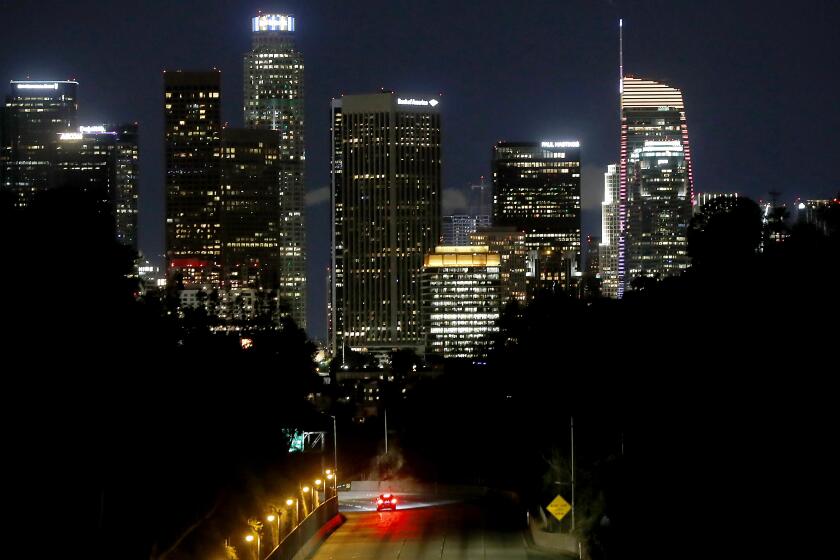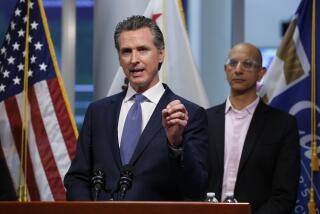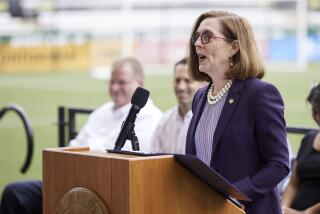California, Oregon and Washington to work together on plan to lift coronavirus restrictions

- Share via
SACRAMENTO — Gov. Gavin Newsom and his counterparts in Washington and Oregon announced “a regional pact to recovery” from the coronavirus crisis on Monday and agreed to work together to develop a plan to lift restrictions on daily life and reopen economies along the West Coast.
The announcement comes as six states in the Northeast — New York, New Jersey, Connecticut, Delaware, Pennsylvania and Rhode Island — also agreed to coordinate regional efforts to gradually ease restrictions adopted to prevent the spread of the virus.
“COVID-19 doesn’t follow state or national boundaries,” Newsom, Oregon Gov. Kate Brown and Washington Gov. Jay Inslee said in a statement. “It will take every level of government, working together, and a full picture of what’s happening on the ground.”
Newsom said he intends to provide details Tuesday on California’s strategy to begin to walk back his stay-at-home order and allow businesses to resume functions.
The statement from Newsom and the other governors lacked specific details but said they plan to collectively identify clear “indicators for communities to restart public life and business.” The governors broadly described a few basic principles they agreed to follow as they develop strategies to return some level of normalcy to their states. The governors said they will be guided by data, prioritize health over politics and work together and with local communities.
After the coronavirus pandemic cools down, how will California start getting back to normal? Slowly, methodically and in stages.
“We need to see a decline in the rate of spread of the virus before large-scale reopening, and we will be working in coordination to identify the best metrics to guide this,” the governors said.
The statement also laid out four shared goals to control the virus: protecting vulnerable populations, ensuring the states have enough equipment and hospital workers to provide adequate care, lessening health effects as a result of state orders and developing a strategy to test, track and isolate cases.
The governors made the announcement hours after President Donald Trump tweeted that he, and not governors, will decide when to open up states again.
Newsom, who has often commended the Trump administration’s efforts to work with California during the pandemic, said he expects to continue that collaboration and cooperation with the federal government.
“I have all the confidence in the world moving forward that we will maintain that collaborative spirit in terms of the decision-making that we make here within the state of California as it relates to a road map for recovery and road map to get back to some semblance of normalcy,” Newsom said.
A shared regional strategy is more difficult for Trump to override than individual state plans, said Dana Williamson, a Democratic political strategist and former cabinet secretary to Gov. Jerry Brown.
These are some of the unusual new scenes across the Southland during the coronavirus outbreak.
“It makes it harder for the president to upend something that is already in place when several states are in agreement with it,” Williamson said.
Trump’s suggestion that he will reopen states runs counter to his messaging throughout the pandemic, in which he has resisted taking national action and repeated that state and local authorities should take the lead in their communities, Williamson said.
President Trump claims he ‘calls the shots’ on coronavirus re-openings, but governors on both coasts are banding together to decide when to ease stay-at-home orders.
Newsom discussed transitioning back to regular life days after Mark Ghaly, secretary of the California Health and Human Services agency, said the stay-at-home order and social distancing have slowed the spread of the virus, resulting in fewer hospitalizations than estimates predicted.
Under a worst-case scenario and without any mitigation efforts, state models predicted a peak of nearly 700,000 hospitalizations from COVID-19, Ghaly said Friday. But he noted that adherence to the stay-at-home order, which Newsom announced nearly a month ago, now suggests that “the difference between what we’re seeing today in our hospitals may not be that much different than where we are going to peak in the many weeks to come.”
As of Monday, 22,234 Californians have tested positive for the virus, and 687 have died, Newsom said. The governor said 3,015 people have been hospitalized, including 1,178 who are receiving intensive care.
More to Read
Sign up for Essential California
The most important California stories and recommendations in your inbox every morning.
You may occasionally receive promotional content from the Los Angeles Times.













